FluWatch report: July 5 to July 18, 2015 (Weeks 27 & 28)
Overall summary
- Overall, low influenza activity was reported from jurisdictions.
- An increase in the number of Influenza A(H3N2) in the past weeks has been reported; however, influenza laboratory detections remained low in weeks 27 and 28.
- As of week 28, 7,905 hospitalizations and 598 deaths have been reported from participating regions, which is more than were reported last year at this time (5,414 hospitalizations and 340 deaths).
Are you a primary health care practitioner (General Practitioner, Nurse Practitioner or Registered Nurse) interested in becoming a FluWatch sentinel for the 2014-15 influenza season? Contact us at FluWatch@phac-aspc.gc.ca
On this page
- Influenza/ILI Activity (geographic spread)
- Influenza and Other Respiratory Virus Detections
- Antiviral Resistance
- Influenza Strain Characterizations
- Influenza-like Illness (ILI) Consultation Rate
- Influenza Outbreak Surveillance
- Pharmacy surveillance
- Sentinel Hospital Influenza Surveillance
- Provincial/Territorial Influenza Hospitalizations and Deaths
- Emerging Respiratory Pathogens
- International Influenza Reports

Download the alternative format
(PDF format, 906 KB, 10 pages)
Organization: Public Health Agency of Canada
Date published: 2015-07-24
Related Topics
Influenza/ILI Activity (geographic spread)
In week 28, sporadic activity was reported in regions of Western and Central Canada. Overall, there is low influenza/ILI activity in Canada.
Figure 1. Map of overall influenza/ILI activity level by province and territory, Canada, Week 28
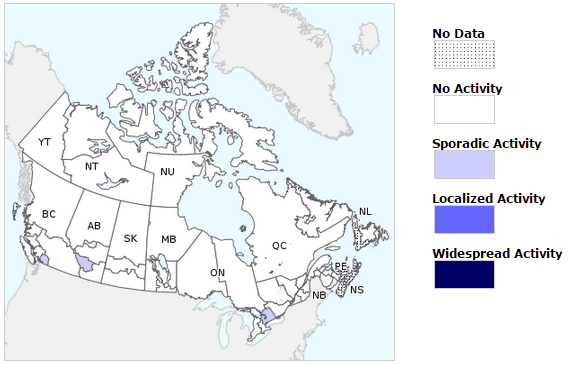
Note: Influenza/ILI activity levels, as represented on this map, are assigned and reported by Provincial and Territorial Ministries of Health, based on laboratory confirmations, sentinel ILI rates and reported outbreaks. Please refer to detailed definitions at the end of the report. Maps from previous weeks, including any retrospective updates, are available on the Flu Activity website.
Figure 1 Map of overall influenza/ILI activity level by province and territory, Canada, Week 30 - Text Description
Influenza and Other Respiratory Virus Detections
Influenza detections are at inter-seasonal levels, with <2% of tests positive for the past three weeks. Most jurisdictions reported low numbers of influenza detections in week 27 and 28 (Table 1). Over the past few weeks, an increase in the number of influenza A(H3N2) has been observed. To date this season, detailed information on age and type/subtype has been received for 37,429 cases (Table 2). Adults ≥65 years of age have predominantly been affected by influenza A, accounting for 62% of influenza A detections.
Figure 2. Number of positive influenza tests and percentage of tests positive, by type, subtype and report week, Canada, 2014-15
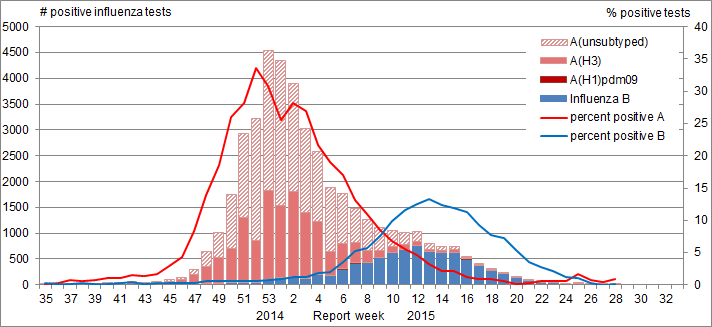
Figure 2 - Text Description
Influenza detections are at inter-seasonal levels, with <2% of tests positive for the past three weeks.
Detections for all other respiratory viruses have continued to decline and have reached inter-seasonal levels (figure 3). In weeks 27 and 28, Rhinovirus was the most predominant virus among other respiratory viruses.
For more details, see the weekly Respiratory Virus Detections in Canada Report.
Figure 3. Number of positive laboratory tests for other respiratory viruses by report week, Canada, 2014-15
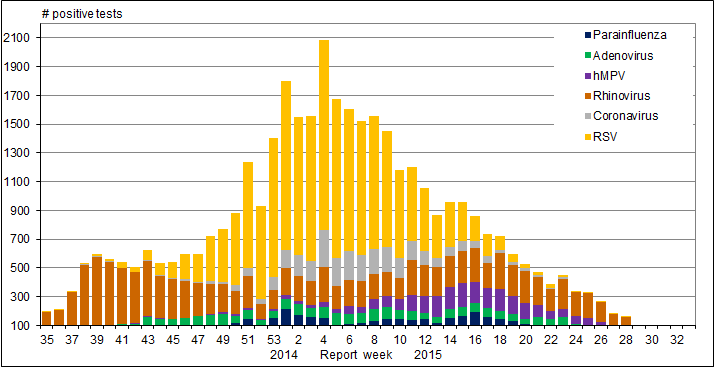
RSV: Respiratory syncytial virus; hMPV: Human metapneumovirus
Figure 3 Number of positive laboratory tests for other respiratory viruses by report week, Canada, 2014-15 - Text Description
| Reporting provincesFootnote 1 | Weekly (July 5 to July 18, 2015) | Cumulative(August 24, 2014 to August 1, 2015) | ||||||||
|---|---|---|---|---|---|---|---|---|---|---|
| Influenza A | B | Influenza A | B | |||||||
| A Total | A(H1)pdm09 | A(H3) | A Footnote (Uns) | B Total | A Total | A(H1)pdm09 | A(H3) | A(UnS) | B Total | |
| BC | 6 | 0 | 6 | 0 | 2 | 3556 | 28 | 2653 | 875 | 506 |
| AB | 2 | 0 | 2 | 0 | 0 | 3713 | 14 | 3544 | 155 | 1006 |
| SK | 0 | 0 | 0 | 0 | 0 | 1320 | 0 | 841 | 479 | 412 |
| MB | 0 | 0 | 0 | 0 | 0 | 1124 | 1 | 390 | 733 | 227 |
| ON | 2 | 0 | 2 | 0 | 0 | 11201 | 51 | 4740 | 6410 | 1554 |
| QC | 1 | 0 | 0 | 1 | 0 | 11460 | 4 | 422 | 11034 | 3912 |
| NB | 0 | 0 | 0 | 0 | 0 | 1196 | 0 | 193 | 1003 | 536 |
| NS | 0 | 0 | 0 | 0 | 0 | 511 | 1 | 123 | 387 | 263 |
| PE | 0 | 0 | 0 | 0 | 0 | 131 | 1 | 128 | 2 | 109 |
| NL | 0 | 0 | 0 | 0 | 0 | 629 | 0 | 123 | 506 | 81 |
| Canada | 11 | 0 | 10 | 1 | 2 | 34841 | 100 | 13157 | 21584 | 8606 |
| Percentage Footnote 2 | 84.6% | 0.0% | 90.9% | 9.1% | 15.4% | 80.2% | 0.3% | 37.8% | 62.0% | 19.8% |
| Age groups (years) | Weekly July 5 to July 18, 2015 | Cumulative (August 24, 2014 to July 18, 2015) | ||||||||||
|---|---|---|---|---|---|---|---|---|---|---|---|---|
| Influenza A | B | Influenza A | B | Influenza A and B | ||||||||
| A Total | A(H1) pdm09 | A(H3) | A Footnote (Uns) | Total | A Total | A(H1) pdm09 | A(H3) | A (UnS) | Total | # | % | |
| <5 | 1 | 0 | 1 | 0 | 0 | 2094 | 23 | 810 | 1261 | 570 | 2664 | 7.1% |
| 5-19 | 2 | 0 | 0 | 2 | 0 | 1785 | 6 | 957 | 822 | 809 | 2594 | 6.9% |
| 20-44 | 1 | 0 | 0 | 1 | 0 | 3463 | 17 | 1684 | 1762 | 1153 | 4616 | 12.3% |
| 45-64 | 1 | 0 | 1 | 0 | 0 | 3890 | 22 | 1670 | 2198 | 1843 | 5733 | 15.3% |
| 65+ | 9 | 0 | 8 | 1 | 0 | 18786 | 13 | 7316 | 11457 | 2931 | 21717 | 58.0% |
| Unknown | 0 | 0 | 0 | 0 | 0 | 120 | 0 | 101 | 19 | 7 | 127 | 0.3% |
| Total | 14 | 0 | 10 | 4 | 0 | 30138 | 81 | 12538 | 17519 | 7313 | 37451 | 100.0% |
| PercentageFootnote 2, | 100.0% | 0.0% | 71.4% | 28.6% | 0.0% | 80.5% | 0.3% | 41.6% | 58.1% | 19.5% | ||
Antiviral Resistance
During the 2014-2015 influenza season, the NML has tested 1,925 influenza viruses for resistance to oseltamivir and 1,923 influenza viruses for resistance to zanamivir. All viruses were sensitive to zanamivir and one influenza A(H3N2) virus was resistant to oseltamivir. A total of 1,492 influenza A viruses (99.9%) were resistant to amantadine (Table 3).
| Virus type and subtype | Oseltamivir | Zanamivir | Amantadine | |||
|---|---|---|---|---|---|---|
| # tested | # resistant (%) | # tested | # resistant (%) | # tested | # resistant (%) | |
| A (H3N2) | 968 | 1 | 966 | 0 | 1458 | 1467 (99.9%) |
| A (H1N1) | 22 | 0 | 22 | 0 | 23 | 23 (100%) |
| B | 968 | 1 | 884 | 0 | NATable 3 - Footnote * | NA Table 3 - Footnote * |
| TOTAL | 1958 | 2 | 1872 | 0 | 1481 | 1480 |
Influenza Strain Characterizations
During the 2014-2015 influenza season, the National Microbiology Laboratory (NML) has characterized 1,127 influenza viruses [212 A(H3N2), 21 A(H1N1) and 894 influenza B].
Influenza A (H3N2): When tested by hemagglutination inhibition (HI) assay (n=212), one virus was antigenically similar to A/Texas/50/2012, five showed reduced titers to A/Texas/50/2012 and 206 were antigenically similar to A/Switzerland/9715293/2013, which is the influenza A(H3N2) component recommended for the 2015 Southern Hemisphere influenza vaccine. Additionally, 1,220 A(H3N2) viruses were unable to be tested by HI assay; however, sequence analysis showed that 1,218 belonged to a genetic group that typically shows reduced titers to A/Texas/50/2012. Influenza A(H1N1): Twenty-one A(H1N1) viruses characterized were antigenically similar to A/California/7/2009. Influenza B: Of the 894 influenza B viruses characterized, 793 viruses were antigenically similar to B/Massachusetts/2/2012, three viruses showed reduced titers against B/Massachusetts/2/2012, and 98 were B/Brisbane/60/2008-like (Figure 4).
Figure 4. Influenza strain characterizations, Canada, 2014-2015, N = 1,127
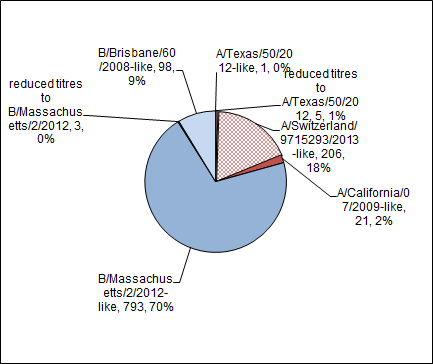
The NML receives a proportion of the number of influenza positive specimens from provincial laboratories for strain characterization and antiviral resistance testing. Characterization data reflect the results of haemagglutination inhibition (HAI) testing compared to the reference influenza strains recommended by WHO.
Figure 4 - Text Description
| Strain | Number of specimens | Percentage |
|---|---|---|
| A/Texas/50/2012-like | 1 | 0% |
| reduced titres to A/Texas/50/2012 | 5 | 1% |
| A/California/07/2009-like | 21 | 2% |
| A/Switzerland/97 15293/2013-like | 206 | 18% |
| B/Massachusetts/2/2012-like | 793 | 70% |
| reduced titres to B/Massachusetts/2/2012 | 3 | 0% |
| B/Brisbane/60/2008-like | 98 | 9% |
Influenza-like Illness (ILI) Consultation Rate
The national influenza-like-illness (ILI) consultation rate decreased from 20.1 consultations per 1,000 in week 27 to 9.9 consultations per 1,000 in week 28 (Figure 5).
Figure 5. Influenza-like-illness (ILI) consultation rates by report week, compared to the 1996-97 through to 2012-13 seasons (with pandemic data suppressed), Canada, 2014-2015
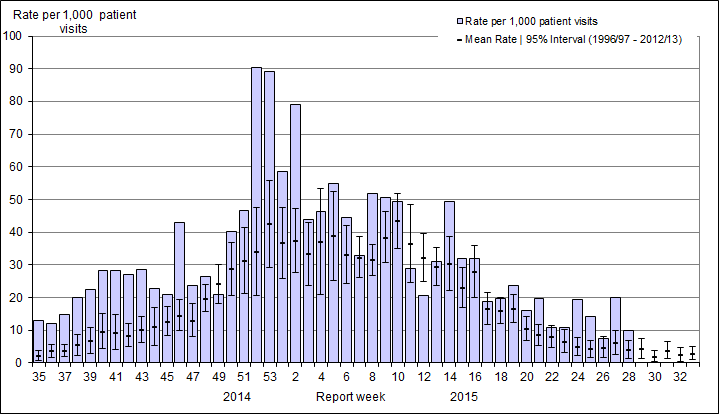
No data available for mean rate for weeks 19 to 39 for the 1996-1997 through 2002-2003 seasons. Delays in the reporting of data may cause data to change retrospectively. The calculation of the average ILI consultation rate over 17 seasons was aligned with influenza activity in each season. In BC, AB, and SK, data is compiled by a provincial sentinel surveillance program for reporting to FluWatch. Not all sentinel physicians report every week.
Figure 5 - Text Description
The national influenza-like-illness (ILI) consultation rate decreased from 20.1 consultations per 1,000 in week 27 to 9.9 consultations per 1,000 in week 28.
Influenza Outbreak Surveillance
In weeks 27 and 28, no new outbreaks of influenza were reported (Figure 6). The last influenza outbreak was reported in week 23. To date this season, 1,279 outbreaks in LTCFs have been reported and the majority of those with known subtypes were attributable to A(H3N2). There have been a higher number of reported influenza outbreaks to date this season compared to the same period in previous seasons.
Figure 6: Overall number of new laboratory-confirmed influenza outbreaks by report week, Canada, 2014-2015
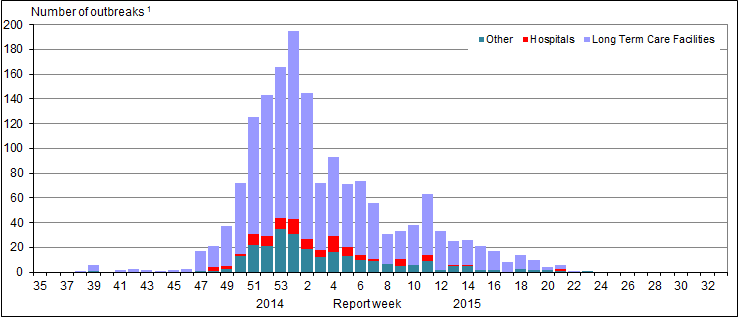
1 All provinces and territories except NU report outbreaks in long-term care facilities. All provinces and territories with the exception of NU and QC report outbreaks in hospitals. Outbreaks of influenza or influenza-like-illness in other facilities are reported to FluWatch but reporting varies between jurisdictions. Outbreak definitions are included at the end of the report.
Figure 6 - Text Description
| Report week | Hospitals | Long Term Care Facilities | Other |
|---|---|---|---|
| 35 | 0 | 0 | 0 |
| 36 | 0 | 0 | 0 |
| 37 | 0 | 0 | 0 |
| 38 | 0 | 1 | 0 |
| 39 | 0 | 5 | 1 |
| 40 | 0 | 0 | 0 |
| 41 | 0 | 2 | 0 |
| 42 | 0 | 3 | 0 |
| 43 | 0 | 2 | 0 |
| 44 | 0 | 1 | 0 |
| 45 | 0 | 2 | 0 |
| 46 | 0 | 3 | 0 |
| 47 | 0 | 16 | 1 |
| 48 | 3 | 17 | 1 |
| 49 | 2 | 32 | 3 |
| 50 | 2 | 57 | 13 |
| 51 | 9 | 94 | 22 |
| 52 | 8 | 114 | 21 |
| 53 | 9 | 122 | 35 |
| 1 | 12 | 152 | 31 |
| 2 | 8 | 118 | 19 |
| 3 | 6 | 54 | 12 |
| 4 | 13 | 64 | 16 |
| 5 | 7 | 51 | 13 |
| 6 | 4 | 60 | 10 |
| 7 | 2 | 45 | 9 |
| 8 | 0 | 24 | 7 |
| 9 | 6 | 22 | 10 |
| 10 | 0 | 32 | 19 |
| 11 | 5 | 49 | 11 |
| 12 | 0 | 31 | 4 |
| 13 | 1 | 19 | 9 |
| 14 | 1 | 20 | 9 |
| 15 | 0 | 19 | 2 |
| 16 | 0 | 15 | 2 |
| 17 | 0 | 8 | 0 |
| 18 | 0 | 11 | 3 |
| 19 | 0 | 8 | 2 |
| 20 | 0 | 2 | 2 |
| 21 | 2 | 3 | 1 |
| 22 | 0 | 1 | 0 |
| 23 | 0 | 0 | 1 |
| 24 | 0 | 0 | 0 |
| 25 | 0 | 0 | 0 |
| 26 | 0 | 0 | 0 |
| 27 | 0 | 0 | 0 |
| 28 | 0 | 0 | 0 |
Pharmacy surveillance
Pharmacy surveillance for sales of influenza antivirals has ended for the 2014-2015 influenza season (Figure 7).
Figure 7. Proportion of prescription sales for influenza antivirals by age-group and week, Canada, 2014-15
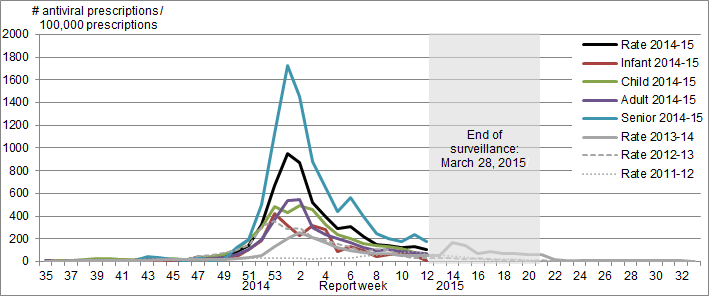
Note: Pharmacy sales data are provided to the Public Health Agency of Canada by Rx Canada Inc. and sourced from major retail drug chains representing over 2,500 stores nationwide (excluding Nunavut) in 85% of Health Regions. Data provided include the number of new antiviral prescriptions (for Tamiflu and Relenza) and the total number of new prescriptions dispensed by Province/Territory and age group. Age-groups: Infant: 0-2y, Child: 2-18y; Adult: 19-64y, Senior: ≥65y
Figure 7 - Text Description
Pharmacy surveillance has ended for the 2014-15 season.
Sentinel Hospital Influenza Surveillance
Paediatric Influenza Hospitalizations and Deaths (IMPACT)
In weeks 27 and 28, no laboratory-confirmed influenza-associated paediatric (≤16 years of age) hospitalizations were reported by the Immunization Monitoring Program Active (IMPACT) network. No ICU admissions were reported.
To date this season, 713 hospitalizations have been reported by the IMPACT network, 512 (72%) of which were cases of influenza A. Among cases for which the influenza A subtype was reported, 98% (163/166) were A(H3N2) (Table 4). To date, 102 cases were admitted to the ICU, of which 58 (57%) were 2 to 9 years of age (Figure 9a). A total of 67 ICU cases reported to have at least one underlying condition or comorbidity. Five deaths have been reported.
Note: The number of hospitalizations reported through IMPACT represents a subset of all influenza-associated paediatric hospitalizations in Canada. Delays in the reporting of data may cause data to change retrospectively.
Adult Influenza Hospitalizations and Deaths (CIRN)
Surveillance has ended for the 2014-2015 influenza season.
This season, 2,228 cases have been reported; 1,912 (86%) with influenza A. The majority of cases (81%) were among adults ≥65 years of age (Table 5). One hundred and seventy two ICU admissions have been reported and 128 cases were adults ≥65 years of age. Among the 172 ICU admissions, 27 were due to influenza B (12 in adults 45 to 64 years of age and 15 in adults over the age of 65). A total of 123 ICU cases (72%) reported to have at least one underlying condition or comorbidity. Of the 123 ICU cases with known immunization status, 40 (33%) reported not having been vaccinated this season. One hundred and thirty-five deaths have been reported, 124 (92%) of the deaths were adults >65 years of age (Figure 9B).
Note: The number of hospitalizations reported through CIRN represents a subset of all influenza-associated adult hospitalizations in Canada. Delays in the reporting of data may cause data to change retrospectively.
| Age groups | Cumulative (Aug. 24, 2014 to July 18, 2015) | |||||
|---|---|---|---|---|---|---|
| Influenza A | B | Influenza A and B | ||||
| A Total | A(H1) pdm09 | A(H3) | AFootnote (Uns) | Total | # (%) | |
| 0-5m | 84 | 0 | 19 | 65 | 16 | 100 (14.0%) |
| 6-23m | 116 | 2 | 36 | 78 | 43 | 159 (22.3%) |
| 2-4y | 122 | 1 | 39 | 82 | 52 | 174 (24.4%) |
| 5-9y | 129 | 0 | 44 | 85 | 54 | 183 (25.7%) |
| 10-16y | 61 | 0 | 25 | 36 | 36 | 97 (13.6%) |
| Total | 512 | 3 | 163 | 346 | 201 | 713 |
| % Footnote 1 | 71.8% | 0.6% | 31.8% | 67.6% | 28.2% | 100.0% |
| Age groups | Cumulative (November 15, 2014 to May 2, 2015) | |||||
|---|---|---|---|---|---|---|
| Influenza A | B | Influenza A and B | ||||
| A Total | A(H1) pdm09 | A(H3) | AFootnote (Uns) | Total | # (%) | |
| 16-20 | 3 | 0 | 1 | 2 | 1 | 4 (%) |
| 20-44 | 106 | 1 | 56 | 49 | 16 | 122 (5%) |
| 45-64 | 217 | 3 | 99 | 115 | 76 | 293 (13%) |
| 65+ | 1586 | 4 | 760 | 822 | 223 | 1809 (81%) |
| Total | 1912 | 8 | 916 | 988 | 316 | 2228 |
| % Footnote 1 | 86% | 0% | 48% | 52% | 14% | 100% |
Figure 8 - Number of cases of influenza reported by sentinel hospital networks, by week, Canada, 2014-15
8A) Paediatric hospitalizations (≤16 years of age, IMPACT)
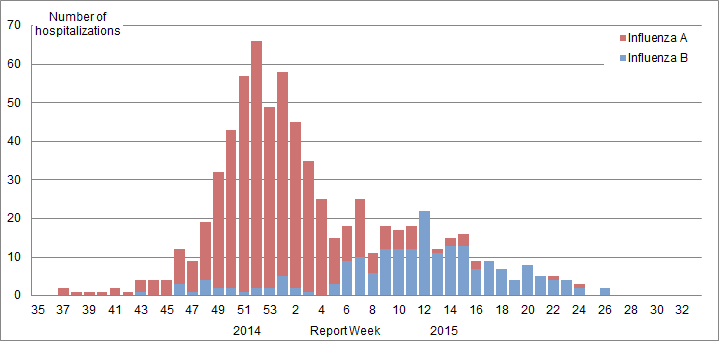
Figure 8A - Text Description
| Report week | Influenza A | Influenza B |
|---|---|---|
| 35 | 0 | 0 |
| 36 | 0 | 0 |
| 37 | 2 | 0 |
| 38 | 1 | 0 |
| 39 | 1 | 0 |
| 40 | 1 | 0 |
| 41 | 2 | 0 |
| 42 | 1 | 0 |
| 43 | 3 | 1 |
| 44 | 4 | 0 |
| 45 | 4 | 0 |
| 46 | 9 | 3 |
| 47 | 8 | 1 |
| 48 | 15 | 4 |
| 49 | 30 | 2 |
| 50 | 41 | 2 |
| 51 | 56 | 1 |
| 52 | 64 | 2 |
| 53 | 47 | 2 |
| 1 | 54 | 5 |
| 2 | 43 | 2 |
| 3 | 34 | 1 |
| 4 | 25 | 1 |
| 5 | 12 | 3 |
| 6 | 9 | 9 |
| 7 | 15 | 10 |
| 8 | 5 | 6 |
| 9 | 6 | 12 |
| 10 | 4 | 12 |
| 11 | 6 | 12 |
| 12 | 0 | 22 |
| 13 | 1 | 11 |
| 14 | 2 | 12 |
| 15 | 2 | 14 |
| 16 | 2 | 7 |
| 17 | 0 | 10 |
| 18 | 0 | 7 |
| 19 | 0 | 4 |
| 20 | 0 | 8 |
| 21 | 0 | 5 |
| 22 | 1 | 4 |
| 23 | 0 | 4 |
| 24 | 1 | 2 |
| 25 | 0 | 0 |
| 26 | 0 | 2 |
| 27 | 0 | 0 |
| 28 | 0 | 0 |
Figure 8B - Number of cases of influenza reported by sentinel hospital networks, by week, Canada, 2014-15
8B) Adult hospitalizations (≥16 year of age, PCIRN-SOS)
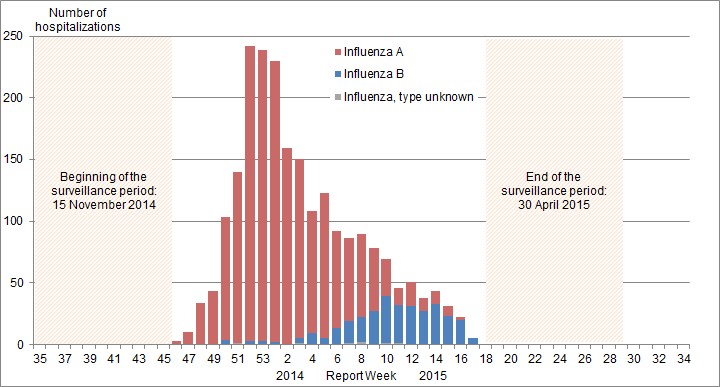
Note: Data for week 46 is based on data collected for 1 day only and do not represent the number of hospitalizations for the entire week.
Figure 8B - Text Description
| Report week | Influenza A | Influenza B | Untyped |
|---|---|---|---|
| 35 | n/a | n/a | n/a |
| 36 | n/a | n/a | n/a |
| 37 | n/a | n/a | n/a |
| 38 | n/a | n/a | n/a |
| 39 | n/a | n/a | n/a |
| 40 | n/a | n/a | n/a |
| 41 | n/a | n/a | n/a |
| 42 | n/a | n/a | n/a |
| 43 | n/a | n/a | n/a |
| 44 | n/a | n/a | n/a |
| 45 | n/a | n/a | n/a |
| 46 | 3 | 0 | 0 |
| 47 | 10 | 0 | 0 |
| 48 | 34 | 0 | 0 |
| 49 | 43 | 0 | 0 |
| 50 | 99 | 4 | 0 |
| 51 | 139 | 0 | 1 |
| 52 | 239 | 3 | 0 |
| 53 | 236 | 3 | 0 |
| 1 | 228 | 2 | 0 |
| 2 | 159 | 0 | 0 |
| 3 | 145 | 4 | 1 |
| 4 | 99 | 9 | 0 |
| 5 | 118 | 5 | 0 |
| 6 | 79 | 13 | 0 |
| 7 | 67 | 18 | 1 |
| 8 | 68 | 20 | 2 |
| 9 | 51 | 27 | 0 |
| 10 | 30 | 38 | 1 |
| 11 | 14 | 31 | 1 |
| 12 | 20 | 31 | 0 |
| 13 | 11 | 27 | 0 |
| 14 | 10 | 33 | 0 |
| 15 | 8 | 23 | 0 |
| 16 | 2 | 20 | 0 |
| 17 | 0 | 5 | 0 |
| 18 | |||
| 19 | |||
| 20 | |||
| 21 | |||
| 22 | |||
| 23 | |||
| 24 | |||
| 25 | |||
| 26 | |||
| 27 | |||
| 28 |
Figure 9 - Percentage of hospitalizations, ICU admissions and deaths with influenza reported by age-group, Canada, 2014-15
9A) Paediatric hospitalizations (≤16 years of age, IMPACT)

Figure 9A - Text Description
| Age-group (years) | Hospitalizations(n=713) | ICU admissions(n=102) |
|---|---|---|
| 0-5m | 14.0% | 2.9% |
| 6-23m | 22.3% | 21.6% |
| 2-4y | 24.4% | 32.4% |
| 5-9y | 25.7% | 24.5% |
| 10-16y | 13.6% | 18.6% |
9B) Adult hospitalizations (≥16 year of age, PCIRN-SOS)

Figure 9B - Text Description
| Age-group (years) | Hospitalizations (n=2228) | ICU admissions(n=172) | Deaths (n=135) |
|---|---|---|---|
| 16-20 | 0.2% | 0.0% | 0.0% |
| 20-44 | 5.5% | 5.2% | 2.2% |
| 45-64 | 13.2% | 20.3% | 5.9% |
| 65+ | 81.2% | 74.4% | 91.9% |
Provincial/Territorial Influenza Hospitalizations and Deaths
In week 28, 36 laboratory-confirmed influenza-associated hospitalizations were reported from participating provinces and territoriesFootnote *. Of the 36 hospitalizations, 27 (75%) were due to influenza A and 16 (44%) were in patients ≥65 years of age.
Since the start of the 2014-15 season, 7,905 hospitalizations have been reported; 6,779 (86%) with influenza A. Among cases for which the subtype of influenza A was reported, 99.2% were A(H3N2). The majority of cases (70%) were ≥65 years of age (Table 6). A total of 395 ICU admissions have been reported to date: 51% (n=203) were in adults ≥65 years of age and 75% were due to influenza A. A total of 598 deaths have been reported since the start of the season: three children <5 years of age, five children 5-19 years, 45 adults 20-64 years, and 545 adults ≥65 years of age. Influenza A has been reported in 91% of deaths. Adults 65 years of age or older represent 91% of all deaths reported this season. Detailed clinical information (e.g. underlying medical conditions) is not known for these cases
| Age groups | Cumulative (24 August 2014 to 18 July 2015) | |||||
|---|---|---|---|---|---|---|
| Influenza A | B | Influenza A and B | ||||
| A Total | A(H1) pdm09 | A(H3) | AFootnote (Uns) | Total | # (%) | |
| 0-4 years | 439 | 6 | 154 | 279 | 97 | 536 (7%) |
| 5-19 years | 286 | 2 | 137 | 147 | 118 | 404 (5%) |
| 20-44 years | 406 | 4 | 247 | 155 | 136 | 542 (7%) |
| 45-64 years | 651 | 10 | 285 | 356 | 162 | 813 (10%) |
| 65+ years | 4943 | 5 | 2377 | 2561 | 589 | 5532 (70%) |
| Unknown | 54 | 0 | 51 | 3 | 24 | 78 (1%) |
| Total | 6779 | 27 | 3251 | 3501 | 1126 | 7905 |
| Percentage Footnote 1 | 85.8% | 0.4% | 48.0% | 51.6% | 14.2% | 100.0% |
See additional data on Reported Influenza Hospitalizations and Deaths in Canada: 2009-10 to 2014-15 on the Public Health Agency of Canada website.
Emerging Respiratory Pathogens
Human Avian Influenza
Influenza A(H7N9): Since the last FluWatch report, six new laboratory-confirmed cases of human infection with avian influenza A(H7N9) virus were reported by the World Health Organization. Globally to July 23, 2015, the WHO reported a total of 678 laboratory-confirmed human cases with avian influenza A(H7N9) virus, including 275 deaths. Documents related to the public health risk of influenza A(H7N9), as well as guidance for health professionals and advice for the public is updated regularly on the following websites:
PHAC - Avian influenza A(H7N9)
WHO - Avian Influenza A(H7N9)
Middle East Respiratory Syndrome Coronavirus (MERS-CoV)
No new confirmed cases of MERS CoV in Korea have been reported since July 7, 2015. This outbreak has resulted in 186 cases including 36 deaths. The Government of Korea continues to implement intense case and contact management activities.
As of July 21, 2015, five contacts are being monitored. Globally, from September 2012 to July 23, 2015, the WHO has reported a total of 1,368 laboratory-confirmed cases of infection with MERS-CoV, including 490 deaths. The public health risk posed by MERS-CoV in Canada remains low (see the PHAC Assessment of Public Health Risk).
Documents related to the public health risk of MERS-CoV, as well as guidance for health professionals and advice for the public is updated regularly on the following websites:
International Influenza Reports
- World Health Organization influenza update
- World Health Organization FluNet
- WHO Influenza at the human-animal interface
- Centers for Disease Control and Prevention seasonal influenza report
- European Centre for Disease Prevention and Control - epidemiological data
- South Africa Influenza surveillance report
- New Zealand Public Health Surveillance
- Australia Influenza Report
- Pan-American Health Organization Influenza Situation Report
FluWatch definitions for the 2014-2015 season
Abbreviations: Newfoundland/Labrador (NL), Prince Edward Island (PE), New Brunswick (NB), Nova Scotia (NS), Quebec (QC), Ontario (ON), Manitoba (MB), Saskatchewan (SK), Alberta (AB), British Columbia (BC), Yukon (YT), Northwest Territories (NT), Nunavut (NU).
Influenza-like-illness (ILI): Acute onset of respiratory illness with fever and cough and with one or more of the following - sore throat, arthralgia, myalgia, or prostration which is likely due to influenza. In children under 5, gastrointestinal symptoms may also be present. In patients under 5 or 65 and older, fever may not be prominent.
ILI/Influenza outbreaks
- Schools:
-
Greater than 10% absenteeism (or absenteeism that is higher (e.g. >5-10%) than expected level as determined by school or public health authority) which is likely due to ILI.
Note: it is recommended that ILI school outbreaks be laboratory confirmed at the beginning of influenza season as it may be the first indication of community transmission in an area. - Hospitals and residential institutions:
- two or more cases of ILI within a seven-day period, including at least one laboratory confirmed case. Institutional outbreaks should be reported within 24 hours of identification. Residential institutions include but not limited to long-term care facilities ( LTCF) and prisons.
- Workplace:
- Greater than 10% absenteeism on any day which is most likely due to ILI.
- Other settings:
- two or more cases of ILI within a seven-day period, including at least one laboratory confirmed case; i.e. closed communities.
Note that reporting of outbreaks of influenza/ILI from different types of facilities differs between jurisdictions.
Influenza/ILI activity level
1 = No activity: no laboratory-confirmed influenza detections in the reporting week, however, sporadically occurring ILI may be reported
2 = Sporadic: sporadically occurring ILI and lab confirmed influenza detection(s) with no outbreaks detected within the influenza surveillance region Footnote †
3 = Localized:
- evidence of increased ILIFootnote * and
- lab confirmed influenza detection(s) together with
- outbreaks in schools, hospitals, residential institutions and/or other types of facilities occurring in less than 50% of the influenza surveillance regionFootnote †
4 = Widespread:
- evidence of increased ILIFootnote * and
- lab confirmed influenza detection(s) together with
- outbreaks in schools, hospitals, residential institutions and/or other types of facilities occurring in greater than or equal to 50% of the influenza surveillance regionFootnote †
Note: ILI data may be reported through sentinel physicians, emergency room visits or health line telephone calls.
We would like to thank all the Fluwatch surveillance partners who are participating in this year's influenza surveillance program.